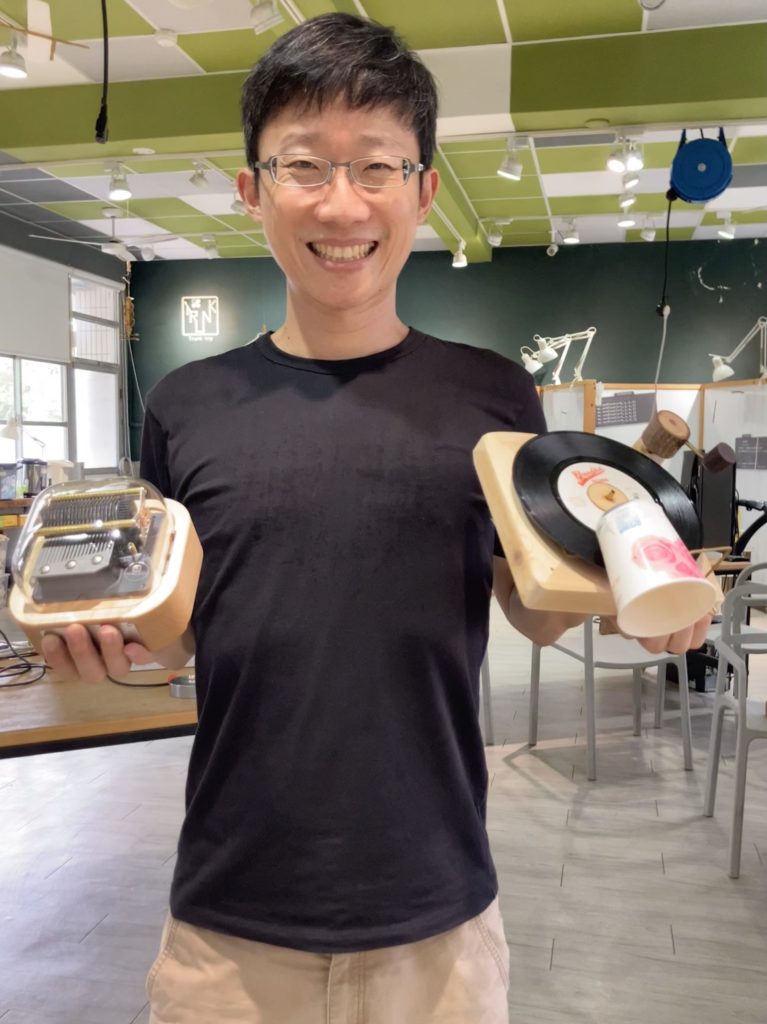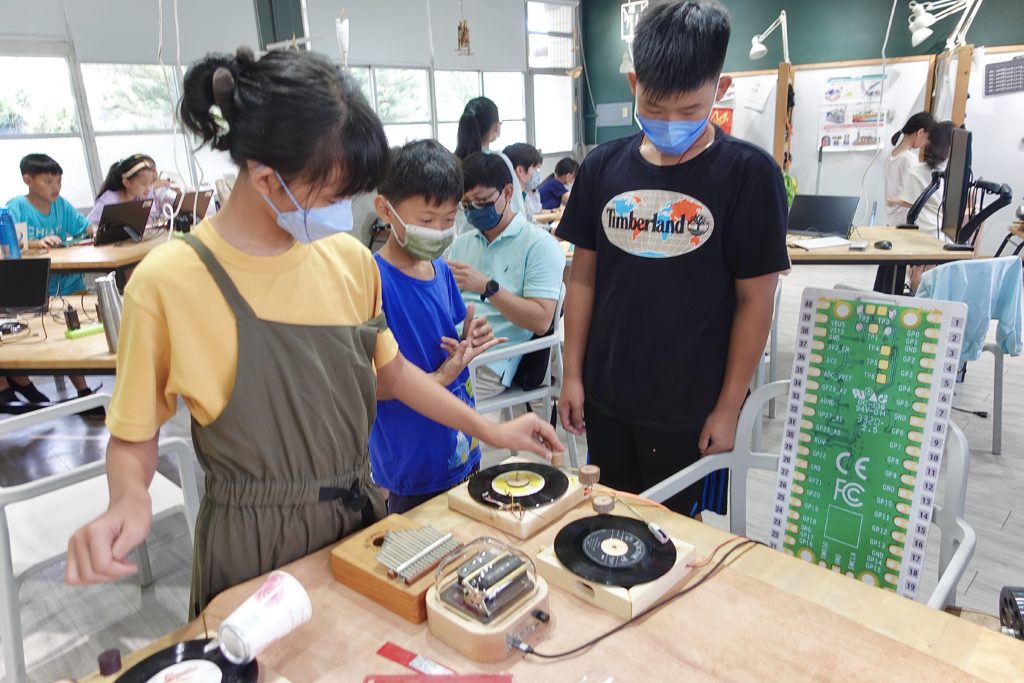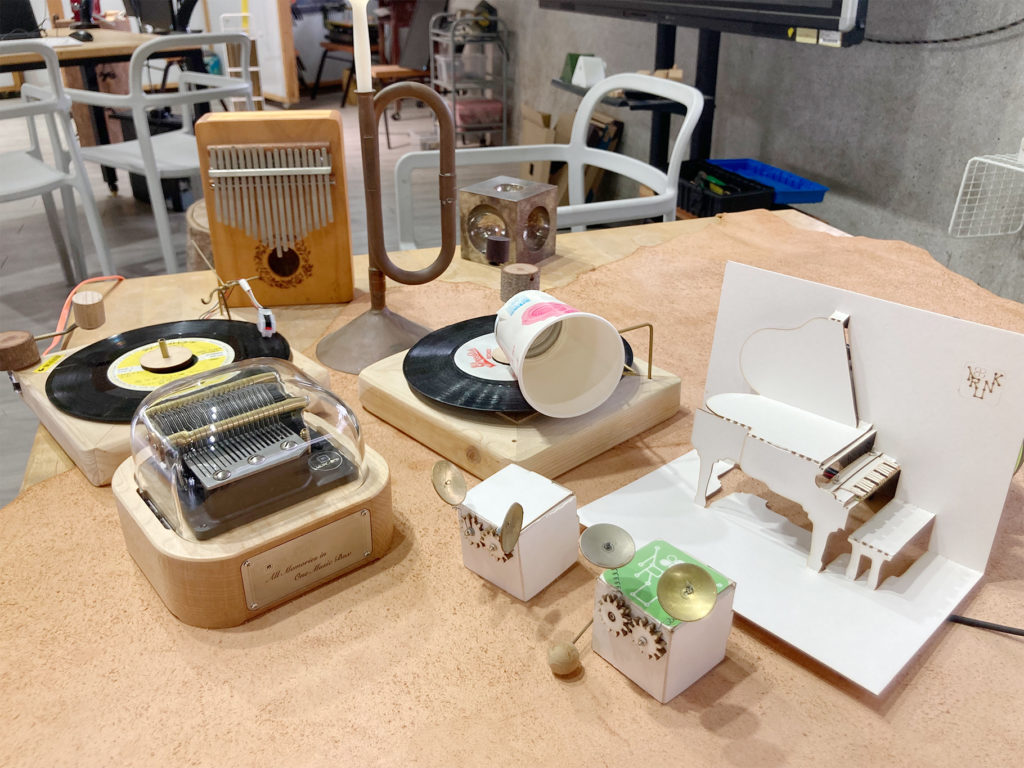Muro Box is My Last Piece of the STEAM Course Design Jigsaw(Taiwan)
Nanshin Junior High School (Tech Center)- Science Teacher: Chyi-Jiunn Wang
Muro Box is My Last Piece of the STEAM Course Design Jigsaw.(Taiwan)
Nanshin Junior High School (Tech Center)- Science Teacher: Chyi-Jiunn Wang
Learning "Sound" through Implementation to Impress Students
Watching students complete a composition in class brings happiness to me!
As a natural science teacher, I used to start with the fundamental elements of sound composition in eighth grade, introducing scientific concepts related to frequency, wave’s form and speed, etc. In order to help students understand the connection between frequency and vibration, I introduced concepts of mass and energy, such as: “When you strike a larger object compared to a smaller one, the larger object is relatively less prone to shaking (resonating),” and the simplest example is comparing thicker strings to relatively thinner strings. Students, especially those in the music class, were able to quickly answer a question like this.
We extended a small portion of a ruler from the edge of a table, pressing one end against the table’s edge while plucking the other end. The frequency of the ruler’s vibrations varied with the length extended beyond the tabletop. The same principle can also be experimented with water filled up to different heights in glasses of the same size and shape. When you use a chopstick to knock the glasses, you can hear them create different sounds because the amount of water varies in each glass.
Students are required to distinguish and even explain the resonances produced by striking and those generated by blowing, and they need to collaborate with classmates to play a simple tune. This truly proved to be a valuable learning experience.

Design STEAM Courses
I had the privilege of visiting San Francisco with the General Director of Tainan City’s Department of Education and some educational partners to observe the implementation of STEAM* education. In the music classroom, we experienced the diverse integration of various instruments into the curriculum. After returning to Taiwan, we carried out related projects at the Technology Center and assisted in developing and executing numerous music-related courses.
Note: STEAM stands for Science, Technology, Engineering, Arts, and Mathematics. Hence, STEAM education crosses the borders of the above subjects and emphasizes on designing inspiring DIY activities to develop students’ problem solving abilities for finding new applications in real life situations.


Muro Box blends science and music education perfectly as a teaching medium.
In the initial stages, my course structure often only focused on DIY music instruments, such as creating brass trumpets, thumb pianos, wind instrument lessons, paper flute sessions, paper pianos, rhythm percussion, hand-cranked record players, and more.
After I encountered the Muro Box, I was truly amazed by its capabilities so I decided to use it in my STEAM course. Not only did I strongly feel that it would be the missing piece in our course series, but also its founder’s valuable product development process could become a focal point to convey to my students: a prime example of task-oriented, and problem-solving learning skill.
In this STEAM parent-child camp course, we embarked on creating an electronic piano. The main intention was to show that programming isn’t as difficult as it may seem to be and to foster parents’ understanding and support for our curriculum.
The course began with a variety of instruments, incorporating different-sized and similar material objects for generating conceptual links in the participants’ minds regarding object size, vibration, and frequency. We supplemented this with the use of music box mechanisms to introduce the concepts of comb, resonator, and power configuration. Throughout the process, I couldn’t help but reminisce about my visit to the Otaru Music Box Museum with my fiancée, where I couldn’t bring back too many music boxes.
I listened to the polite yet uncontainable exclamations of the student.It became evident that this music box is Taiwan’s pride, much like the grandeur of the pipe organ at the Weiwuying National Kaohsiung Center for the Arts.
How to Use Muro Box in My Lesson Plans
During the execution of the electronic piano creation, I always mention to the students the oscillators, filters, and amplifiers used in electronic music. This hands-on music course with technological assistance involves managing the input and output of electronic signals and switching between digital and analog controls.
Muro Box goes even further by providing hands-on experience with the Internet of Things (IoT) MQTT technology, which is undoubtedly the best example for the Raspberry Pico W development board we use.
Guiding the students through step-by-step soldering and programming their own musical pieces, they gradually gain an understanding of the differences between analog and digital signals. As expected, some students even asked how to adjust the volume of the music box. I demonstrated by placing it on different surfaces such as wood tables, glass, and leather to illustrate the variations. I also introduced the convenient functions of the Muro Box App, explaining how the tunes created within the app can be translated into codes.
After these two sessions, I strongly felt that the course time was insufficient. Three hours could only provide a very rough overview. In the upcoming information classes, I will be teaching ninth-grade music students. I’m contemplating whether I could supplement their education with motor control and even electromagnet control when they study electromagnetics. At that time, Muro Box will remain my trusted teaching companion. The only minor regret might be that I didn’t buy enough units of it!

How did I find the Muro Box?
I first learned about Muro Box during a crowdfunding campaign. While I was aware of it, I didn’t take any action because I wasn’t ready at the time. I would envision the possible production process of this music box, anticipate the challenges their team might encounter, and consider feasible production methods if they had available resources. This entire process has been fascinating and embodies a concept that I want to convey to my students: waiting until you have a solution before looking at others’ approaches, engaging in discussions, making modifications from material choices to processes, all of which contribute to gaining practical experiences.
One day, a page popped up on Facebook that led me to their official website, where I learned I could experience Muro Box online. I immediately downloaded the app, composed music on my phone, and streamed the delightful melodies produced by the Muro Box. It was smooth and beautiful! I was so eager to have it!
Apart from deeply admiring the entire team’s efforts, I seriously absorbed the product development journey. Each passage of text resonated with me, showcasing an unyielding determination. Their motivation inspires me. When I face challenges in the early stages of developing teaching materials, I always realize that being a professional means taking risks. I just need more attempts and greater patience to find new solutions.
With this aspiration in mind, I shared the idea of this one music box playing unlimited melodies with my wife, saying that finally someone had made it a reality. I conveyed the concept I wanted to support and began planning how to integrate it into my curriculum. When I reached out to them via their Facebook chat. I received a remarkably swift response – from the CEO of Muro Box! This overwhelmed me with gratitude. While I can only express a few words, I’m thankful for their openness in sharing their development journey. In my heart, the valuable experiences gained from failure and their detailed records in this product development journey have elevated the product’s value beyond itself, making it a part of cultural heritage.
From placing the order to receiving the shipment took only two days. Besides the Muro Box itself, there was also a card handwritten by the CEO inside the postal package. Apart from immediately playing with it, I can also continue to closely follow the development journey of the upcoming Muro Box-N40. Needless to say, it’s truly an enjoyable experience!
